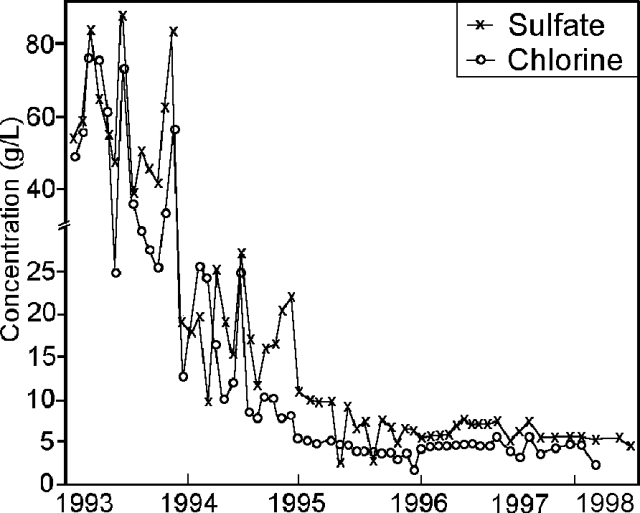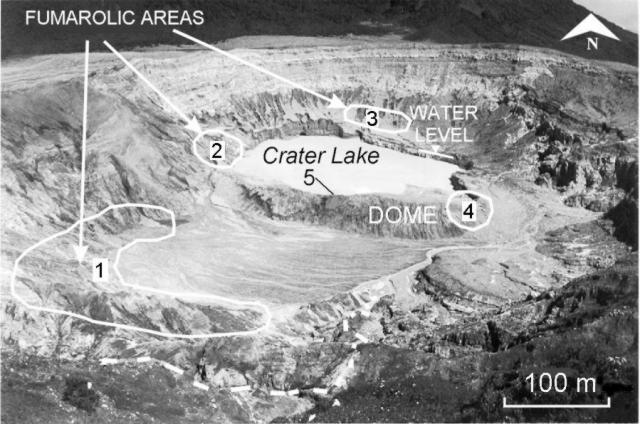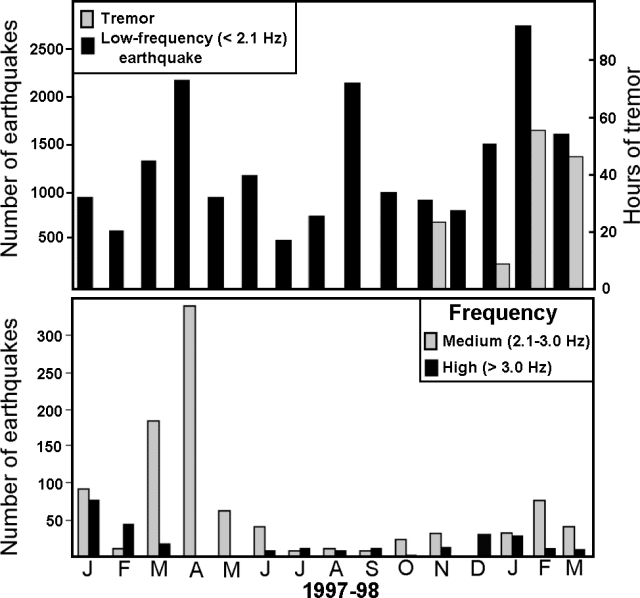Report on Poas (Costa Rica) — March 1998
Bulletin of the Global Volcanism Network, vol. 23, no. 3 (March 1998)
Managing Editor: Richard Wunderman.
Poas (Costa Rica) Fumarolic vigor, tremor, and earthquakes high during February
Please cite this report as:
Global Volcanism Program, 1998. Report on Poas (Costa Rica) (Wunderman, R., ed.). Bulletin of the Global Volcanism Network, 23:3. Smithsonian Institution. https://doi.org/10.5479/si.GVP.BGVN199803-345040
Poas
Costa Rica
10.2°N, 84.233°W; summit elev. 2697 m
All times are local (unless otherwise noted)
Poás monthly reports from OVSICORI-UNA since November 1997, and as recently as March, have noted that its N crater lake has remained turquoise green and continued to host rafts of suspended sulfur. The lake's surface normally sits at ~2,300 m elevation. Although during 1997 the lake's surface reached a high stand, it descended during early 1998, dropping 3 m due to lack of rain. Mauricio Mora Fernandez provided plots of the lake water's pH, temperature, sulfate, and chlorine for the past several years (figures 67 and 68). Fernandez also reported that during February 1998 fumarolic activity continued in five areas within the active crater (figure 69). During April, he found a sixth fumarolic area on the dome's N slope.
Area 1, the fumarolic field located at the crater's S end, became active in May 1995 and remained comparatively stable thermally until at least March. During 1997-early 1998, the field extended S, SW, and W within the larger crater. During February 1998, the area's average temperature remained constant at ~92°C; during April, it attained 93°C. Steam and high concentrations of SO2 and Cl gas escaped from the fumaroles; sulfur crystals were deposited around the vents. Mora noted that in the time since the fumaroles appeared, hydrothermal alteration became more rapid and reduced competency of the rock, leading up to two landslides in the area.
In area 2, the field W of the crater lake, a large landslide occurred during February. It took place at a spot where hydrothermal alteration resulted from three fumaroles that sent white gas plumes dominantly toward the SW. More fumaroles sprung up in this field during April.
In area 3, the field at the lake's N end, new fumaroles appeared during roughly the second half of 1997. These continued without important changes through April 1998; their emissions were white and not very vigorous.
In area 4, a field on the dome's E slope, small fumaroles produced white plumes. The emissions were not vigorous but their average February-April temperatures were 92-93°C. Some new fumaroles noted in this area during April had temperatures averaging 93°C.
In areas 5 and 6, fields located respectively on the dome's E and N slopes, vigorous fumaroles gave off mainly white plumes. During April, area 5 plumes had temperatures of 92°C and ascended to tens of meters before dispersing. Area 6, which became active in April, gave off plumes that covered the nearby slope with sulfur deposits.
OVSICORI-UNA reported that the pyroclastic cone in the crater discharged a plume that during January rose 400 m above the crater rim. They also noted that during February the rain collection network located around the active crater yielded samples with increased acidity. During this same month, residents 5.5 km SE of the crater reported occasional sulfur odors.
Seismic data from an OVSICORI-UNA station 2.7 km SW of the active crater revealed a noticeable rise in the duration of tremor during February and March 1998. Tremor generally occurred in discontinuous episodes, although one episode on 21 February carried on for 2.5 hours. Also, an anomalously large number of low-frequency earthquakes took place during February 1998 (figure 70)—a count of this magnitude was last seen in January 1996. In contrast, medium and high frequency earthquakes were not particularly abundant in February or March 1998 (figure 70). Many of the low-frequency earthquakes were attributed to continuous degassing.
Geological Summary. The broad vegetated edifice of Poás, one of the most active volcanoes of Costa Rica, contains three craters along a N-S line. The frequently visited multi-hued summit crater lakes of the basaltic-to-dacitic volcano are easily accessible by vehicle from the nearby capital city of San José. A N-S-trending fissure cutting the complex stratovolcano extends to the lower N flank, where it has produced the Congo stratovolcano and several lake-filled maars. The southernmost of the two summit crater lakes, Botos, last erupted about 7,500 years ago. The more prominent geothermally heated northern lake, Laguna Caliente, is one of the world's most acidic natural lakes, with a pH of near zero. It has been the site of frequent phreatic and phreatomagmatic eruptions since an eruption was reported in 1828. Eruptions often include geyser-like ejections of crater-lake water.
Information Contacts: E. Fernandez, V. Barboza, R. Van der Laat, R. Saenz, E. Duarte, E. Malavassi, T. Marino, M. Martinez, and E. Hernandez, Observatorio Vulcanologico y Sismologico de Costa Rica, Universidad Nacional (OVSICORI-UNA), Apartado 86-3000, Heredia, Costa Rica; Mauricio Mora Fernandez, Sección de Sismologia, Vulcanologia y Exploración Geofisica, Escuela Centroamericana de Geología, Universidad de Costa Rica, P.O. Box 35-2060, San José, Costa Rica.





